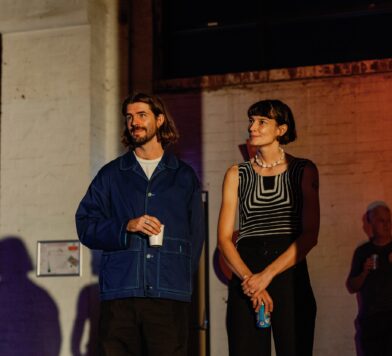
“They take wealth from our country, leaving behind a huge open cut pit and toxic waste rock pile for us to clean up.”
The roads, pipes and wires that make up the infrastructure of our towns and cities aren’t often considered to have moral dimension. But, as Dr Liam Grealy investigates, we are, quite literally, building inequality into our urban fabric.
In August 2017, ten inches of rain over four hours led to days of flooding in central New Orleans – from the Seventh Ward to Treméto Mid-City to Lakeview. City officials claimed the pump system was working but that rain outstripped capacity. But subsequent revelations of a power-station control-panel fir e offered a partial explanation for the drainage failure. Three of the five turbine generators that power New Orleans’ 120 pumps were already down for maintenance and with one on fire, just one was left to manage the downpour. Sixteen of the pumps were also down, despite contrary initial reports, for which senior Sewerage and Water Board and Public Works Department staff were quickly asked to resign. A ritual sacking provided a swift and visible response to the more complex infrastructural challenges of managing subterranean “vibrant matter”[1].

Image: Liam Grealy
Situated on drained former swampland, below (a rising) sea level, sinking, and adjacent to the disappearing protective wetlands of the Louisiana Gulf Coast, living with water is the perennial challenge of the crescent city. Every storm season, flooding elicits memories of the devastation wreaked by Hurricane Katrina in 2005, when the repeatedly-predicted failure of the US Army Corps of Engineers’ “city of walls”[2]– that is, levees, embankments, floodwalls, and other rigid barriers – came to fruition. Technocratic explanations for the levee failure, offered in a progressivist vein to promote further construction, elide the complexly entangled negligence of regulatory, maintenance, planning, and disaster recovery regimes. They also discount historical explanations for the former and ongoing racialization of infrastructural risks, such as access to high ground, the geography of redlining, federal compensation programs, and insurance determinations bearing on who was able to return post-disaster.
When the 2017 floods arrived, the demography of some of America’s oldest black neighbourhoods had already shifted: social infrastructures had been razed and replaced by foreclosure, eviction, gentrification, and short-term rentals for the tourist economy.

Image: Liam Grealy
Eight months later, in Australia’s top end, the remote community of Borroloola faced its own man-made hydrological catastrophe. Indigenous residents called on the Northern Territory Department of Health in April 2018 to blood-test community members following water samples revealing elevated levels of lead and manganese in the drinking water supplies of town camps. Glencore’s nearby McArthur River Mine had previously confessed to poisoning cattle and fish via zinc and lead leached from its dumpsite, generating suspicion over its ongoing role in contaminating local water systems. As Jacky Green narrates in Yee-haw, Money Trucks (2017)[3], “They take wealth from our country, leaving behind a huge open cut pit and toxic waste rock pile for us to clean up.”
In this recent instance, the Department of Health and the government-owned Power and Water Corporation suggested the contamination occurred between the bore and the tap, with corroded brass fittings in the camps’ internal reticulation systems a likely cause. The extensively detailed Town Camps Review (2017) had already recommended urgent upgrades to the camps’ water infrastructure. Yet with assessments made without subterranean investigation, and with incomplete historical records, just what’s down there, when it was installed, and who’s responsible for it, remains opaque. It was almost two months before residents in Garawa 1 camp were advised the water was again safe to drink, with the Department of Health noting that “the problem . . . was more complicated than originally thought.” Community members know all too well that having such issues investigated is hard fought, requiring sustained protest and advocacy in the face of multiple pressing issues that demand their attention. In October 2018 a new water treatment plant was opened in Borroloola, however further extensions are required to service housing on the east of the McArthur River, including at Garawa 1 and Garawa 2 camps.

Image: Liam Grealy
“It’s exhausting to create an event out of nothing”, says one of anthropologist Chloe Ahmann’s[4] (2018) Baltimore informants about the difficulty of representing the cumulative effects of infrastructural slow violence. The distribution of both displacement for infrastructural development – think highway and “urban renewal” projects – and risk of harm – think waste dumps, chemical factories, and mine sites – are never demographically equal, but are instead central to the ongoing reenactments of settler-colonialism’s voracious appropriation of territory and capitalism’s serial frontiers of extraction and abandonment. Such geographies of governance are variously conceptualised by Evelyn Araluen as “cartographies of colonisation” (2018; also see 2019[5]), by Stephen Lerner[6] (2010) as “sacrifice zones”, and by Elizabeth Povinelli[7] (2011) as “economies of abandonment”. They are constituted, in part, by the extension (or not) of infrastructures, as “material forms that allow for the possibility of exchange over space” (Larkin 2013)[8]. Of course, the construction, use, and maintenance of infrastructures can also dispossess, degrade, and disconnect. Most of the time, residents at the metaphorical and literal coalface of environmental and financial hazards lack a Hurricane Katrina, or a Northern Territory Intervention, to spectacularly expose the slow-to-accrue cumulative toxicities of infrastructural failure. Even when industrial disasters are major events, such as Union Carbide’s Bhopal disaster in 1984, their effects long outlast the cameras, the aid money, academic interest, and even the attention of community organisers overwhelmed by the demands of acute crises and new looming threats. The ongoing groundwater contamination at Bhopal signals what Nikhil Anand[9] (2015) describes as “the work of ignorance in maintaining state institutions”: proof of harm, the designation of culpability, and eventually redress, first require investigation.

Image: Liam Grealy
Bringing the harms of infrastructural violence to light is always tough political work, and efforts to do so are confronted by reductionist interpretive habits, or cultural clichés. Poor health is explained by dietary and lifestyle choices, or the dilapidated remote community house signifies tenant damage rather than, as the not-for-profit organisation Healthabitat has shown, a lack of routine maintenance and poor initial construction. We need to acknowledge that infrastructure is always in motion, ageing, and trending toward entropy. It is rarely “completed”, instability is its norm, and functionality requires constant attention: tinkering, fix-work, maintenance, replacement, patches, upgrades, and renovation. Such labour requires government resources, and monitoring and accountability systems that recognise the natural decline of infrastructures, rather than simply attributing breakdowns to users. The recent victory for public housing tenants in the Central Australian community of Santa Teresa – awarded compensation for the government’s failure to ensure their homes were maintained to a habitable standard – shows the potential for redress via public litigation, but also the risks associated with asserting basic legal rights (including countersuits, administrative labour, insecure tenancy, and so on).
Most readers of this essay can probably still take potable and plentiful tap water largely for granted. As many writers have conceived of infrastructure in general – that it becomes visible when it breaks down – so too are our expectations made apparent through disruption: an occasional boil water alert, for example. With a scarce commodity literally on tap, we can forget the already quotidian everyday realities of many global cities – Cape Town, Mumbai, and São Paulo among them – variously characterised by water’s undersupply, privatisation, and rationing. This while future-focused fantasies of being overwhelmed by water and of water’s disappearance have become increasingly central to speculative dystopias in popular culture: of flooded worlds, desert wastelands, and “water knives”[10]. We should also direct our imaginations to how the right to water might be guaranteed under conditions of increasing scarcity. What political work is required to ensure the redistribution of this natural wealth from wasteful industries that benefit a small minority to serve the basic needs of everyone? Such imaginative work must contend with fantasies of water’s infinity facilitated through techno-fixes, such as proliferating desalination plants, and the tendencies of such “solutions” to mortgage the future on behalf of contemporary lifestyles.

Image: Liam Grealy
All strategies for sustainable futures struggle with the sinking mess of the present. As at Borroloola, the reticulated infrastructure delivering drinking water to New Orleans’ residents has also exhibited levels of lead beyond safe drinking standards. 65-80 per cent of city pipes are almost two centuries old. Shortly before the 2017 floods, the New Orleans Office of the Inspector General found that residents could be exposed to lead by construction projects shaking the metal loose from old pipes. This construction includes a 135mile Federal Emergency Management Agency funded water-line replacement project, which promised to remove the problem it is shaking loose; this in a context where the city admits it doesn’t know the locations of all the existing lead service lines. Given this material was once the industry standard, such ignorance isn’t surprising, but nonetheless requires further government intervention. Thus the legacy of yesterday’s infrastructural promise is today’s public health hazard. Importantly, and despite the identified dangers of the pipes to residents’ drinking water, the Sewerage and Water Board of New Orleans is only replacing waterlines on public property.
If lead is leaching from and flowing through the pipes, how might we respond to the fact that the state doesn’t know what’s down below or determines that its responsibility extends only to the edges of public land? How might water bind us in ways that thinking about broken infrastructure in our own backyards and elsewhere does not? Writing about Flint, Michigan, anthropologist Catherine Fennell (2016) [11] notes the discursive similarities between the claims “We are all Flint” and “All lives matter”. In practice, such statements convey “the kind of risks that a far-flung group of citizens can recognize as shared, and thus worthy of collective concern and action, and those that will, despite their ubiquity, seem isolated events that will never break the surface of widespread attention.” Where the contamination of municipal pipes is liable to produce “hydraulic publics” (Anand 2017) [12] through citizen science initiatives demanding government responses, in contrast, the failure of housing to also support healthy living practices has been more difficult to articulate and engender such collective demands and actions around. Compared with pipes that leach lead, the inability to access housing, (let alone secure tenancy in affordable housing that supports tenants’ positive health outcomes) is more likely to be explained by individual shortcoming.
In the United States especially, the shift from public housing to the curtailed state provision of vouchers for housing in the private market has also effected a privatisation of responsibility for infrastructural failure. This is evident in the logic of pipe replacements in New Orleans: householders, or in what is now a city of majority renters, landlords, are responsible for replacing pipes from the curb to the kitchen. The privatisation of infrastructural provision and failure, or in Ara Wilson’s (2016)[13]phrase, the “unbundling” of public infrastructure under neoliberalism, exacerbates the contemporary “concrete divide”[14] between the infrastructural haves and have-nots. Often presuming models of home-owner tenants, building science recommendations for healthy homes are typically quiet on the means renters might use to improve their water or their indoor air quality without risking eviction by punitive landlords. Put differently, while affordable housing advocacy might prioritise the issue of domestic infrastructure’s effects on tenants’ health, on behalf of establishing minimum healthy housing standards, building scientists and hygienists must also become advocates of tenants’ rights.
As Fennell writes, “while ‘we’ might all be at risk of ingesting toxins, some of us can spit back the lead soup that leaches from ‘our’ pipes, even as others must swallow the lead dust that flakes off ‘our’ walls.” This is the challenge of infrastructural inequalities: who can spit back what? How can we conceive and respond to problems that are shared, but never evenly? And how do infrastructures themselves give rise to particular kinds of publics and specific potentials for collective action?

Image: Liam Grealy
A version of this essay was originally presented to open the Infrastructural Inequalities public program at Artspace in October 2018 – a collaboration which is ongoing between the Housing for Health Incubator and Snack Syndicate. That event pulled together artists, activists, academics, and other professionals, because facing the challenges of infrastructural inequalities requires responses that are equally creative, collective, critical, and technical. As Sara Ahmed[15] writes, “It takes conscious willed and willful effort not to reproduce an inheritance”, and any work against social reproduction requires a broad coalition, locally organised and institutionally disparate, flexible to internal difference and critique, and open to ongoing reorientation. In the contexts described above, community-led planning and local organising around water monitoring and against further extraction is working towards ensuring the ongoing security of communities in the face of flooding and contamination. As citizens and as allies, we might reflect on how we can contribute to an “infrastructure of dissent”[16], which is a social, intimate infrastructure, and which like concrete can also be “built, material, and lasting”[17].
[1]Bennett, Jane. 2009. Vibrant matter: A political ecology of things. Durham & London: Duke University Press.
[2]Caldeira, Teresa P. R. 2000. City of walls: Crime, segregation, and citizenship in São Paulo. Berkeley: University of California Press.
[3]Green, Jacky. 2017. Yee-haw, money trucks. Artwork.
[4]Ahmann, Chloe. 2018. “It’s exhausting to create an event out of nothing”: Slow violence and the manipulation of time. Cultural Anthropology. 33(1): 142-171.
[5]Quoted in Spring, Joel and Munro, Lorna. 2018. Survival Guide. Radio Skid Row. Accessed: https://soundcloud.com/radio-skid-row/sets/survival-guide; Araluen, Evelyn. 2019. To outlive a home: Poetics of a crumbling domestic. Cordite Poetry Review. 1 February.
[6]Lerner, Stephen. 2010. Sacrifice zones: The front lines of toxic chemical exposure. Cambridge, MA: The MIT Press.
[7]Povinelli, Elizabeth. 2011. Economies of abandonment: Social belonging and endurance in late liberalism. Durham and London: Duke University Press.
[8]Larkin, Brian. 2013. The politics and poetics of infrastructure. Annual Review of Anthropology. 42: 327-343.
[9]Anand, Nikhil. 2015. Leaky states: Water audits, ignorance, and the politics of infrastructure. Public Culture. 27(2): 305-330.
[10]Bacigalupi, Paolo. 2015. The Water Knife. Vintage Books: New York.
[11]Fennell, Catherine. 2016. Are we all Flint? Limn. (7): https://limn.it/articles/are-we-all-flint/
[12]Anand, Nikhil. 2017. Hydraulic city. Durham and London: Duke University Press.
[13]Wilson, Ara. 2016. The infrastructure of intimacy. Signs: Journal of women in culture and society. 41(2): 247-280.
[14]Gandy, Matthew. 2004. Rethinking urban metabolism: Water, space and the modern city. City. 8(3): 363-379.
[15]Ahmed, Sara. 2014. White men. feministkilljoys. 4 November.
[16]Alan Sears quoted in Brett, Matthew. 2015. Building an infrastructure of dissent. New Socialist. 17 February.
[17]Cowen, Deborah. 2017. Infrastructures of empire and resistance. https://www.versobooks.com/blogs/3067-infrastructures-of-empire-and-resistance
Articles / Blog

22 Oct, 2025
UP THERE (Boorloo)
By Emma Brain

21 Oct, 2025
Andrew Broffman in ArchAU
By Emma Brain

05 Aug, 2025
Birrundudu Drawings
By Emma Brain

09 Jul, 2025
B Corp Success – Again!
By Emma Brain

21 May, 2025
Raising funds to protect our forests
By Emma Brain

15 May, 2025
Vessel Contemporary
By Emma Brain

07 May, 2025
2025 National President’s Prize
By Emma Brain

08 Apr, 2025
TFA Xmas Donation
By Emma Brain

25 Mar, 2025
Christina Fogale joins TFA!
By Emma Brain

06 Feb, 2025
Promotions and Expansion at TFA!
By Emma Brain

29 Jan, 2025
TFA Donates to the Save Burrup Hub Campaign
By Emma Brain

23 Jan, 2025
Vale Richard Longley
By Emma Brain











